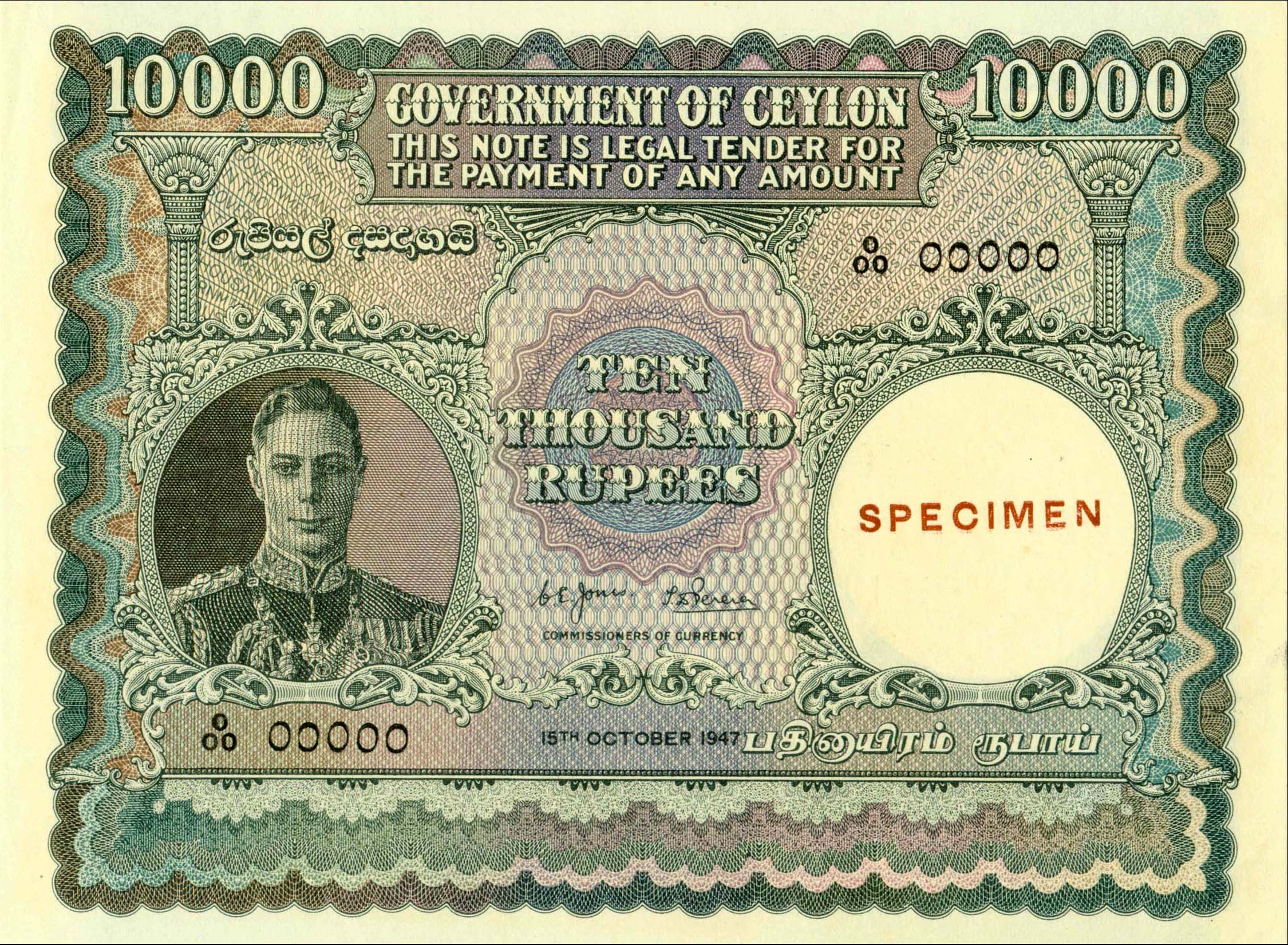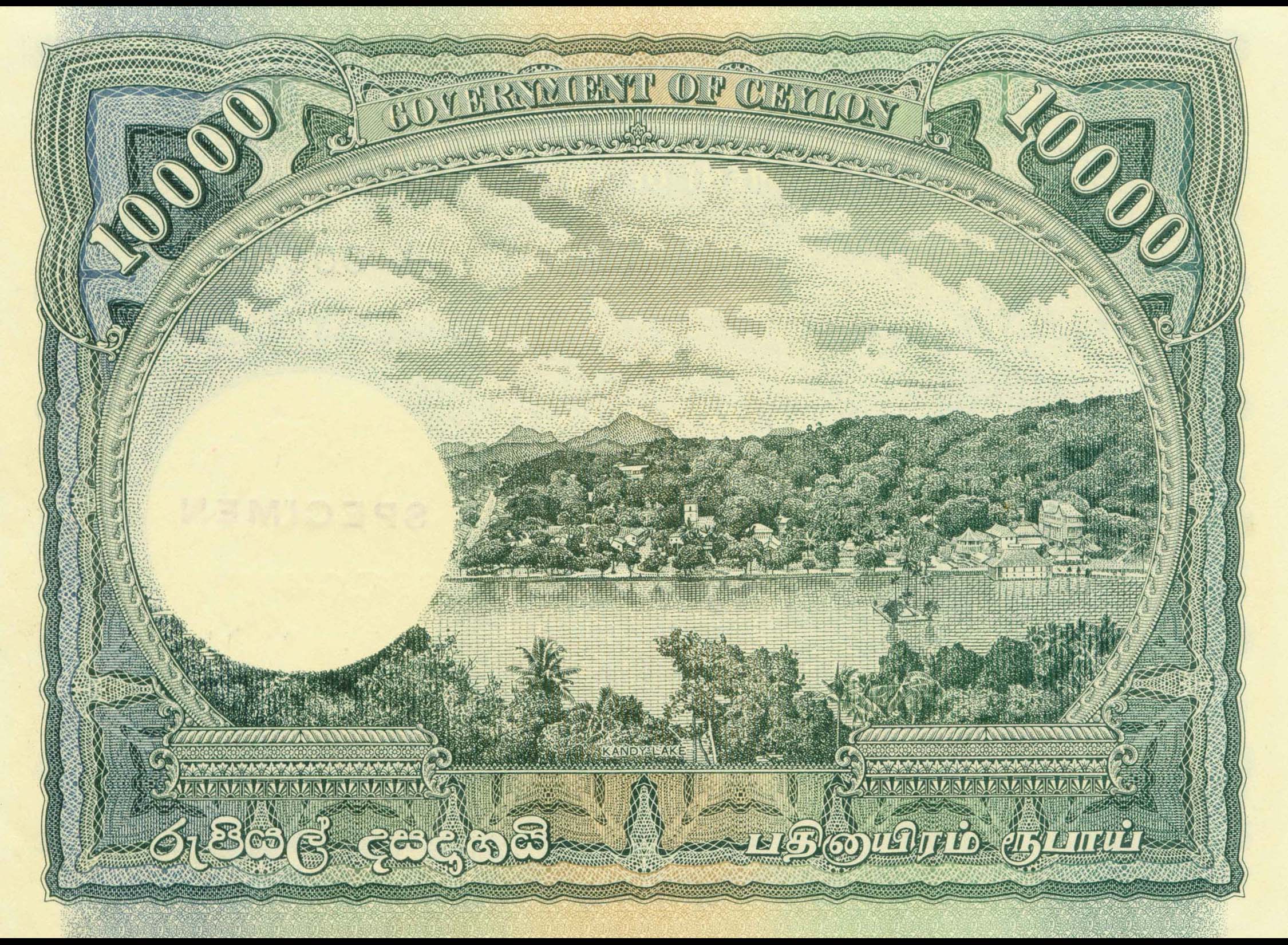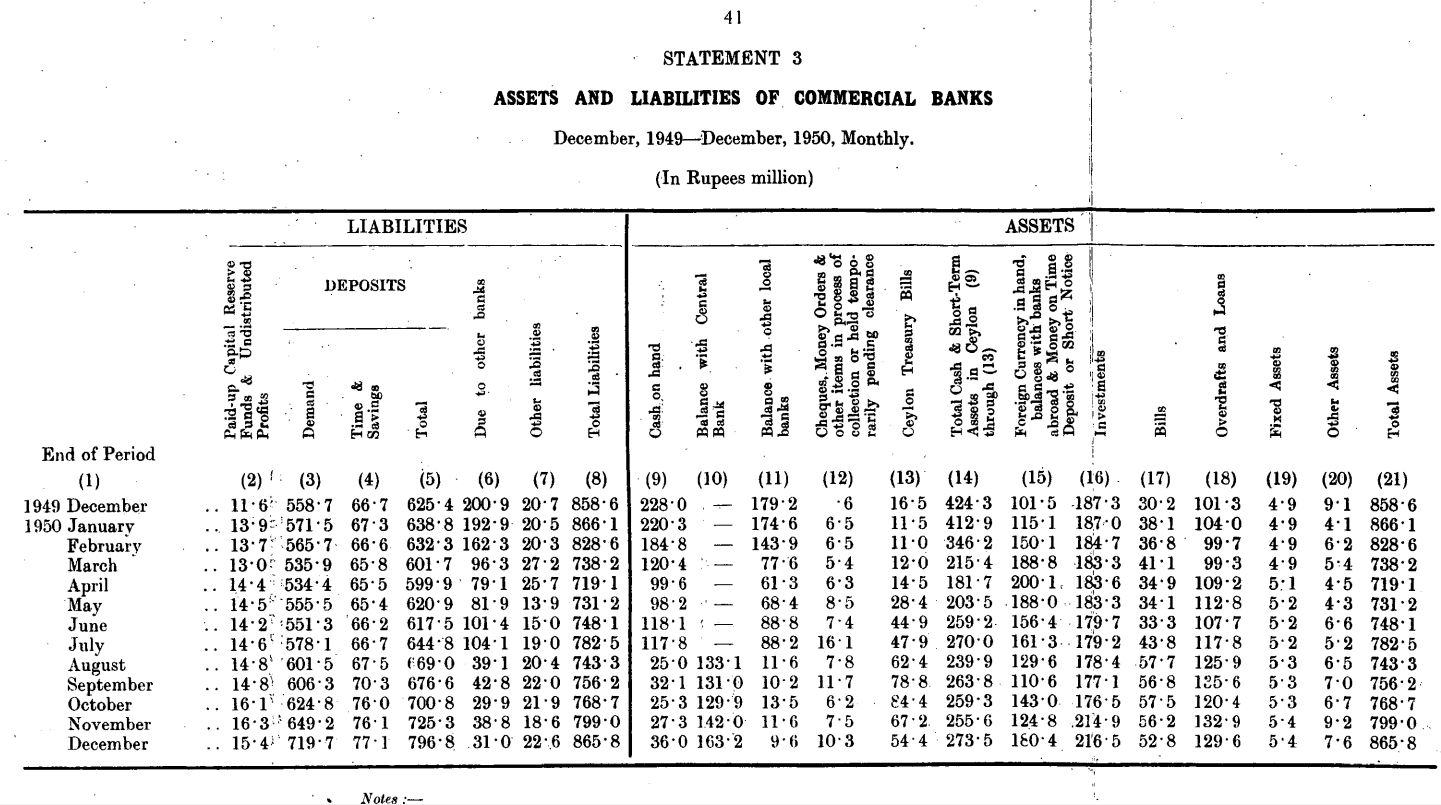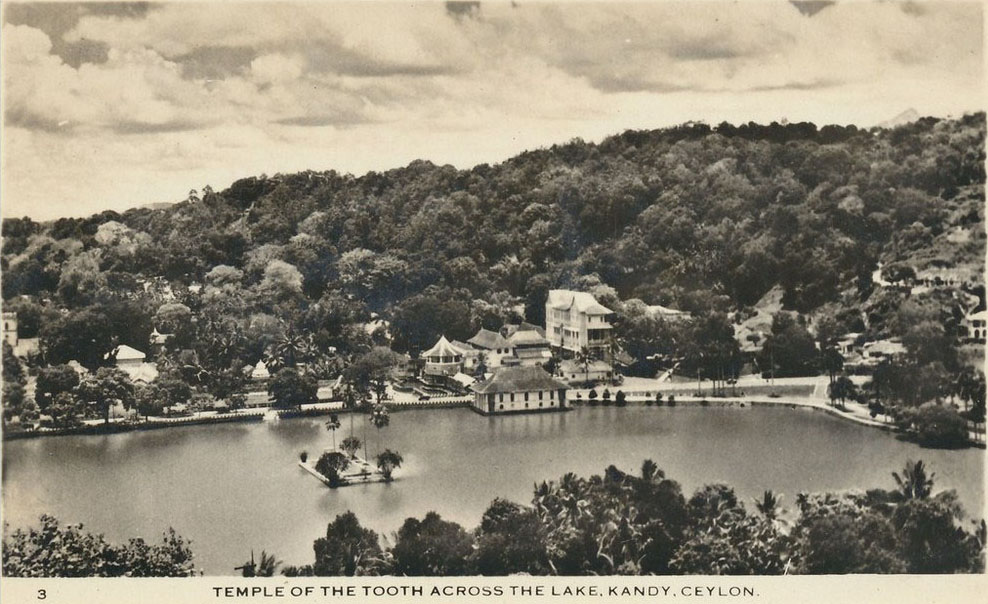


| 
|
| Click on the images to see 1946 CNP Specimen - LK:SCWPM #047 | |
Front : Green on Lilac and blue underprint.
Portrait of King George VI on the left, a water-mark panel on the
right, and the value in words TEN THOUSAND RUPEES in 3 lines in center and
in figures 10000 on the top two corners. GOVERNMENT OF CEYLON
above THIS NOTE IS LEGAL TENDER FOR PAYMENT OF ANY AMOUNT
in two lines.
The date 15TH OCTOBER 1947
appears below the two facsimile signatures of C.E. Jones & T.D. Perera
COMMISSIONERS OF CURRENCY.
The value
රුපියල් දසදාහයි in Sinhala on upper left, and
பதினாயிரவ் ரூபாய் in Thamil on lower right.
The Serial number on the lower left hand side and upper right hand side.
Back : Green on a Lilac and blue tint underprint with Micro printing
text THE GOVERNMENT OF CEYLON. Pictorial at center with
caption KANDY LAKE with small island. Foliage in foreground and
the city of Kandy with the Temple of the Tooth Relic and mountains in
background. The value in figures 10000 slanted on upper two
corners on either side of GOVERNMENT OF CEYLON in an arc. Lower
the value
රුපියල් දසදාහයි in Sinhala on left, and
பதினாயிரவ் ரூபாய் in Thamil on right.
| Signatures of Commissioners of Currency | Date on BankNote | First Serial # | Mintage in K | |
| O.E. Goonetilleke | C.E. Jones | 7TH MAY 1946 | Specimen | 0 |
| C.E. Jones | T.D. Perera | 15TH OCTOBER 1947 | N/1 00001 | 50 |
All notes with denominations Rs 10 and lower dated before 1950
December 31st were demonetized with on 1955 August 26th and ceased to
be legal tender with effect 1956 August 31st.
All Rs 50 and Rs 100 notes dated before 1970 October 26th and ceased
to be legal tender with effect 1970 November 3rd.
All Rs500 and Rs1000 notes were demonetized on 1945 November 15th and
ceased to be legal tender after 1946 January 31st.
 When were the Rs10,000 Notes demonetized?
May not have been announced as they didn't circulate among the public.
The complete online set of
Annual Reports of the Central Bank of Ceylon from 1951 does
not mention the Rs10,000 as being in circulation.
So maybe the Rs10,000 was never taken over by the Central Bank in 1950.
The amount of currency held by Banks drops from Rs118M to 25M between
the end of 1950 July and the End of August 1950 with the inauguration
of the central bank on the 28th and may represent 9,000 of these notes.
See Table on right from 1950 Annual Report of Central Bank of Ceylon.
Need to research the transfer of liability of the Rupees 293 Million
Banknotes in circulation from the Commissioners of Currency to
the Central Bank on 1950 August 28th.
When were the Rs10,000 Notes demonetized?
May not have been announced as they didn't circulate among the public.
The complete online set of
Annual Reports of the Central Bank of Ceylon from 1951 does
not mention the Rs10,000 as being in circulation.
So maybe the Rs10,000 was never taken over by the Central Bank in 1950.
The amount of currency held by Banks drops from Rs118M to 25M between
the end of 1950 July and the End of August 1950 with the inauguration
of the central bank on the 28th and may represent 9,000 of these notes.
See Table on right from 1950 Annual Report of Central Bank of Ceylon.
Need to research the transfer of liability of the Rupees 293 Million
Banknotes in circulation from the Commissioners of Currency to
the Central Bank on 1950 August 28th.

 The details of this issue are from Sri Lanka Currency of Recent
Times 1938-1985 T. M. U. Sallay, 1986 Colombo:Central Bank of Sri Lanka.
The details of this issue are from Sri Lanka Currency of Recent
Times 1938-1985 T. M. U. Sallay, 1986 Colombo:Central Bank of Sri Lanka.
On right is a scan of a Post Card and the photograph of Kandy Lake used by Artist for the line drawing used on the Rs 10,000 KGVI pictorial note.
The Unc Specimen note waa scanned at 300 dpi and displayed at 50 dpi. I thank Mr Tuan Sallay for it.
The King GVI Rs10000 is only known as a Specimen and probably the most
valuable Ceylon Banknote. Two specimens in CBSL Currency Museum are
sadly gummed on to panel and faded over many decades of display.
Another was shown on TV at time of issue of Rs5000
note.
The 2011 publication
60th Anniversary Commemorative Volume of the Central Bank of Sri Lanka has chapter on
Currency issued by the Central Bank of Sri Lanka by Ms. S.H. Gunawardena.
She make a reference to this 1947 Rs10,000 note, but I noticed that
rather then the word SPECIMEN the banknote with the logo of
Currency Note Press (CNP) a division of the India Security Press, Nasik,
and is dated 7TH MAY 1946 and
has signatures of O. E. Goonetilleke and C. E. Jones.
Low resolution 50 dpi image from the PDF was replaced with a
300 dpi image obtained from CBSL via RTI 0134/2021 and posted
below images above. It is clearly more multicolor and redder than the
1947 banknote shown above interbank transactions. It is possible that
the color of the 1947 note I scanned has red color faded like shown with
positive proof for the 1943 Rs 1 note.
To see both sides of the 1946, click on the 1947 images shown above.
It maybe the Notes shown on TV.
Shailen Bhandare of Ashmolean Museum commented that with the 'CNP' mark instead of 'specimen' indicates that this is a colour trial.
I was once told by a dealer that about 20 of these Rs10,000 Specimens are available with collectors worldwide. Some SPECIMEN stamped on notes with non-zero Serial number.
Note Default Unicode Sinhala dhaa දා
is written different to ![]() on this currency note.
on this currency note.
Also default Unicode Tamil naa னா
is written different to ![]() on this currency note.
on this currency note.
All Legal tender notes from in Ceylon since 1941 September and many other Commonwealth Nations states THIS NOTE IS LEGAL TENDER FOR THE PAYMENT OF ANY AMOUNT and so does the words in Sinhala after translation in 1956 with the Sinhala only Act. Since the note is only worth face value, shouldn't it imply within a transaction and say This note is legal tender IN the payment of any amount. The Monetary Act also uses these words and therefor does it have a legal meaning?
In 1947 this note worth a 1000 Gold sovereigns at Rs10 per Spvereign which in 2023-December was worth over Rs170 Million
The Equivalent of this note used only for Bank Transactions is the 1934 US$100,000 note. When it was issued in 1934 was worth 12,137 gold Sovereigns. See also the current British Giant £1 Million note and the Titan £100 Million note- images.
During the 2011 Debt Cealing crisis a US$ 1 Trillion coin was proposed, but never implimented as both the FRB and Treasury rejected the concept.
After the rapid depreciation of the Sri Lankan Rupee in 2022, and the value of the highest denomination Rs5000 dropping to US$13.50 there was speculation of a Rs10,000 note, that was denied in RTI reply from CBSL. Few Images of Fantasy Rs10,000 notes were shared on Social Media and went Viral and were FactChecked